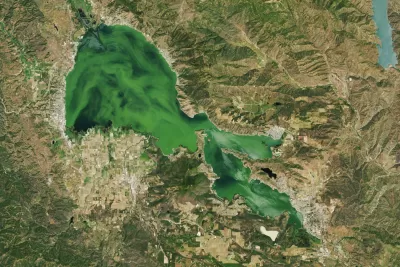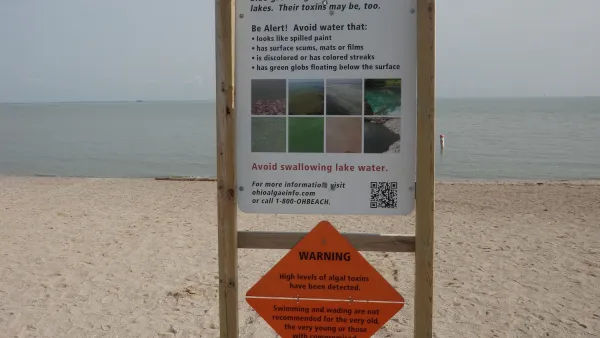A potentially toxic algal bloom has turned Clear Lake in Northern California bright green, fed by increased runoff from human activity.

“Clear Lake, one of California’s oldest and most-visited lakes, is not so clear anymore after an algal bloom turned the water cloudy and green,” reports Terry Castleman for the Los Angeles Times. Located about 60 miles north of the San Francisco Bay, the 43,000-acre freshwater lake is a popular destination for boaters, fishers, and swimmers, but those activities will likely be affected for weeks to come.
The bloom may be comprised of blue-green algae, also known as cyanobacteria, which produce a toxin that can irritate the skin and cause liver and kidney damage. According to Nasa, “Algal blooms have been common in Clear Lake’s long history, but have grown more common with human activity in the last century,” including runoff from nearby farms, vineyards, faulty septic systems, gravel mines, and an abandoned open-pit mercury mine, as well as from nonnative carp stirring up the nutrients in the lake bed’s sediment.
Cyanobacteria is the same type of toxic algae that has bloomed extensively in Lake Erie over the last several years, most notably in 2014 when residents in Toledo, Ohio, were unable to drink, cook with, or brush their teeth with water for three days. States across the country are dealing with algae blooms due to nutrient run-off, impacting local water quality and water-based tourism, including Cape Cod.
FULL STORY: Shocking before-and-after photos show California’s famed Clear Lake turn bright green

Maui's Vacation Rental Debate Turns Ugly
Verbal attacks, misinformation campaigns and fistfights plague a high-stakes debate to convert thousands of vacation rentals into long-term housing.

Planetizen Federal Action Tracker
A weekly monitor of how Trump’s orders and actions are impacting planners and planning in America.

In Urban Planning, AI Prompting Could be the New Design Thinking
Creativity has long been key to great urban design. What if we see AI as our new creative partner?

King County Supportive Housing Program Offers Hope for Unhoused Residents
The county is taking a ‘Housing First’ approach that prioritizes getting people into housing, then offering wraparound supportive services.

Researchers Use AI to Get Clearer Picture of US Housing
Analysts are using artificial intelligence to supercharge their research by allowing them to comb through data faster. Though these AI tools can be error prone, they save time and housing researchers are optimistic about the future.

Making Shared Micromobility More Inclusive
Cities and shared mobility system operators can do more to include people with disabilities in planning and operations, per a new report.
Urban Design for Planners 1: Software Tools
This six-course series explores essential urban design concepts using open source software and equips planners with the tools they need to participate fully in the urban design process.
Planning for Universal Design
Learn the tools for implementing Universal Design in planning regulations.
planning NEXT
Appalachian Highlands Housing Partners
Mpact (founded as Rail~Volution)
City of Camden Redevelopment Agency
City of Astoria
City of Portland
City of Laramie





























